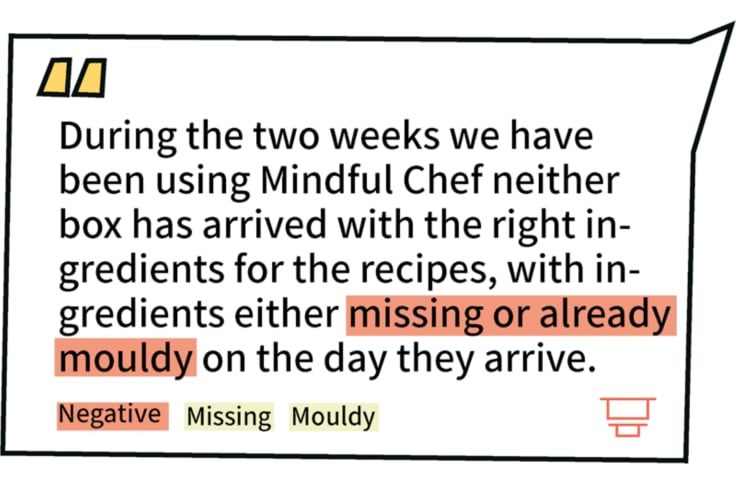Showing top 0 results 0 results found
Showing top 0 results 0 results found

Brand advocates boost your growth exponentially. A customer who only buys from you once is valuable. But one that keeps coming back for more and brings their friends with them? That’s the dream.
We passed more than 300,000 Trustpilot reviews through our customer analytics software in the hope that we'd uncover the truth behind what makes a customer an advocate. The reviews uncovered what customers love and hate about their customer experience. The analysis covered companies from industries like banking (challenger banks), ecommerce furniture stores, and food and recipe subscription boxes.
We found that customers tend to leave reviews when they’re either really happy or really annoyed. This finding is great for understanding what creates these strong emotions. What it boils down to are these five rules. You must follow the five rules if you want to create love (loyalty, advocacy, and bigger cart size) and avoid hate (churn, negative advocacy, and low acquisition).
Rule 1: You need to nail your customer service
Research suggests that across online industries, customer support is highly valued by customers. On average, 12% of reviews in the three industry sectors we examined were driven by customer support interactions. Whether the reviews are negative or positive, there are clear patterns that tell us what customers love about customer support and what drives them up the wall.
When mentioning customer support in a positive light, consumers typically mentioned that the way they handled complaints was friendly, useful, and quick. Interestingly, their positive experience with service was normally part of a larger positive review and not the main focus. This indicates that while creating delight for the customer, it was somewhat expected.
We see the opposite in negative reviews. Customers frequently mentioned “no response” or “difficult to contact” in dedicated negative reviews. Reviewers who didn’t get a response were particularly venomous towards the company.

We saw similar reviews left for banks in the financial technology (fintech) sector. Speed of response, some were particularly wowed when it took just minutes to resolve a complaint, drove positive reviews. However, access to support was a clear pain point, with customers mentioning a lack of in-app support or difficulty finding a way to contact the provider.

The key takeaway here is that when a customer has a complaint, they expect to have it heard. Customers are people like you and me, and empathy and listening goes a long way towards creating strong relationships.
Some customers will always slip through the net, but brands have an opportunity to delight them with investment in customer service infrastructure. That infrastructure should focus on friendly, speedy, and highly accessible customer support agents.
Without this, customers feel anxious that they’re losing their hard-earned money and are likely to churn. But, with it, interestingly, customers become brand advocates who’ll stick with you above a competitor.
Rule 2: Seamless is expected
From the reviews, one thing was clear. Customers hate the unexpected. Each industry has its own way of creating an unexpectedly negative customer experience, so you’ll have to work on identifying and tackling your own issues. For example, in the ecommerce furniture industry, customers frequently left vitriolic negative reviews if a piece of furniture arrived damaged (how disappointing) or broke within the first six months (what a waste of money).
We saw similar in other industries. Food and recipe subscription boxes, for example, drive a ton of support tickets when an item is missing, damaged, or spoiled. Customers will come to the reviews to complain when this happens repeatedly. Once can be explained away, but more than once becomes unacceptable.

Food and recipe subscription companies like Mindful Chef, mentioned above, saw overwhelmingly positive reviews for food taste and quality. However, when you’ve planned a meal for the week and your food arrives moldy or with an ingredient missing, it really throws a wrench into your plans. Brands should consider simplifying their offering if it’s hard to deliver while also remaining highly responsive to these churn-inducing issues in order to mitigate them.
Across fintech providers, we see a similar impact of the unexpected. Unexpected fees, frozen or blocked accounts, or the sudden inability to pay with a card all led to a severe reaction. More than 1,500 reviews mentioned a frozen or blocked account across the challenger banks we analyzed.

Across all reviews we looked at, communication was often a defining factor in how annoying the unexpected really was. Customers are likely to be especially vindictive if they’re kept in the dark about why something is happening. This means you can often prevent negative reviews by keeping customer support responsive and efficient.
Rule 3: Create experiences that touch the senses
You’ve probably heard that in copywriting you shouldn’t focus on your features. Instead, you should focus on how life with your product will make your customer feel. Things like whether your customer will be happier, stress free, or have a higher status tend to create a bigger impact than the specific details of your product.
The data here very much confirms that. Across all industries we analyzed, the biggest drivers of positive sentiment were based on experience. In the food and recipe subscription box category, 67% of reviews focused on “meal experience.” Most prominently, taste, ease of cooking, variety, and health drove positive sentiment.
This shows that customers care most about how food and recipe boxes touch their senses. Brands should take note of this and focus their messaging on how much the customer will enjoy their meal, how easy cooking will become now, and how healthy they’ll feel with your recipes and food.

The challenger bank reviews tell a similar story. Convenience was the main driver of positive customer sentiment.

Customers most frequently mentioned easy transactions (37k+ reviews), app usability (30k+ reviews), and instant notification (3k+ reviews).
That sense of ease and the clarity of information that customers can now get in their banking experience was a joy. Clunky tech, hidden information, and time-consuming processes were eliminated by challenger banks, and customers absolutely love it. Their senses of freedom, relief, and ease were stimulated by the contrast between the status quo and the new and improved experience.
That’s a lesson for everyone trying to “wow” customers. This is further confirmed by ecommerce furniture customers who frequently mentioned (53% of reviews) the product experience. Reviews talked about “great packaging” and the “quality feel” of the material.
Brands often forget the small things, but the details that stimulate the customer are what really drive positive sentiment.
Rule 4: Don’t mess with your customer’s money
If there’s one thing brands can do to reduce their customer’s anxiety levels, it’s responding quickly and efficiently to matters involving money. Slow refunds drove thousands of negative reviews. Customers who took weeks to get a refund condemned companies as “disorganized” and their customer service as “appalling.”
There’s nothing more frustrating than receiving the wrong item, returning it, and not getting your money back. Customers who had been waiting a long time for a refund often mentioned that they would never use the company again and warned others to stay away. Similarly, with banking providers, frozen accounts caused a lot of frustration for customers. If they were left without money or were unable to access what is theirs, customers quickly left negative reviews.
Withholding someone's money, especially if they no longer have the product, feels unfair to the customer. Studies show that when a situation is unfair, we have primal reactions that are instinctual. Fairess has evolutionary origins and is not logically driven.
When in that state of mind, customers need excellent customer service and clear communication or they will undoubtedly churn and leave angry reviews. We certainly see this rage when looking at the customer reviews. Here’s a good example: “Reported this company to watchdog SCAM STAY CLEAR!!!! Reported this company to watchdog as it is quite alarming as accounts are blocked then customers ignored, no solution, no contact.”
Rule 5: “Wow” your customer
You have the opportunity to “wow” a customer at every touchpoint. And, if you do, you’re sure to create widespread brand advocacy.
In the UK, when Monzo and Revolut grew their customer base rapidly, the “wow” factor was certainly a large contributor to their growth. Both banks provided a previously unseen level of transaction convenience, and the clarity on customers’ financial situation was wonderful because the banks let them know instantly when money is withdrawn from their account.
For Monzo (touchpoint map pictured below), app usability featured heavily in the reviews as did the ease of budgeting and other financial features. Instant notifications also drove positivity under the convenience theme.

Reviews left for food and recipe subscription boxes tell a similar story. People got the “wow” factor from the product taste and the ease of cooking, things they previously struggled to achieve. Usually, perfecting your core value proposition should create your “wow.” If you’re an online marketplace, like Amazon, your product won’t be it. Instead, your usability, prices, and delivery will be.
However, if you’re a product developer, you must uncover your “why.” In other words, what problem are you trying to solve? Doubling down on that differentiating factor by building both product experience and your marketing around it will help you develop brand clarity and penetrate the market faster.
In the ecommerce furniture market, we saw Wayfair perform particularly well when it came to packaging. Packaging quality was mentioned in nearly 2,000 reviews. On the other hand, MADE.com had just 100 reviews on that topic. Details like a well-packaged product create delight along the customer journey that clearly encourage customers to become brand advocates.
Creating brand advocates
Loving a brand is a funny thing. We all want brand advocates singing our praises through word of mouth, but few companies are willing to truly understand what’s creating customer friction.
Following these five rules will guide you to what customers truly love, and hate, about their experience with a company. But, you’ll need to dig deeper and invest in the right tools to understand your own customers deeply enough to know their particular quirks.







Comments